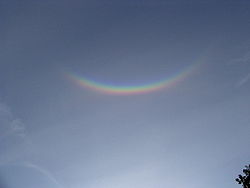
Circumzenithal arc
Encyclopedia


Rainbow
A rainbow is an optical and meteorological phenomenon that causes a spectrum of light to appear in the sky when the Sun shines on to droplets of moisture in the Earth's atmosphere. It takes the form of a multicoloured arc...
; but it arises from refraction
Refraction
Refraction is the change in direction of a wave due to a change in its speed. It is essentially a surface phenomenon . The phenomenon is mainly in governance to the law of conservation of energy. The proper explanation would be that due to change of medium, the phase velocity of the wave is changed...
of sunlight through horizontally-oriented ice crystals
Ice crystals
Ice crystals are a small crystalline form of ice including hexagonal columns, hexagonal plates, dendritic crystals, and diamond dust. The highly symmetric shapes are due to depositional growth, namely, direct deposition of water vapour onto the ice crystal...
, generally in cirrus clouds, rather than from raindrops. It forms no more than one-quarter of a circle centered on the zenith
Zenith
The zenith is an imaginary point directly "above" a particular location, on the imaginary celestial sphere. "Above" means in the vertical direction opposite to the apparent gravitational force at that location. The opposite direction, i.e...
and on the same side as the sun
Sun
The Sun is the star at the center of the Solar System. It is almost perfectly spherical and consists of hot plasma interwoven with magnetic fields...
. Its colors are from blue on the inside to red on the outside of the arc. It is one of the brightest and most colorful halos
Halo (optical phenomenon)
A halo from Greek ἅλως; also known as a nimbus, icebow or gloriole) is an optical phenomenon produced by ice crystals creating colored or white arcs and spots in the sky. Many are near the sun or moon but others are elsewhere and even in the opposite part of the sky...
. Its colors are purer than those of the rainbow because there is much less color overlap in its formation. The first impression is that of an upside-down rainbow.
The circumzenithal arc has been called "a smile in the sky". It is rarely noticed because it occurs so far overhead, but in fact is relatively common. Cirrus clouds which cause a sun dog
Sun dog
A sun dog or sundog, scientific name parhelion ; , also called a mock sun or a phantom sun, is an atmospheric phenomenon that creates bright spots of light in the sky, often on a luminous ring or halo on either side of the sun.Sundogs may appear as a colored patch of light to the left or right of...
can cause a circumzenithal arc when they reach the zenith, if the Sun is low in the sky.
The light that forms the CZA enters an ice crystal through its flat top face, and exits through a side prism face. The refraction of almost parallel sunlight through what is essentially a 90-degree prism accounts for the wide color separation and the purity of color. The CZA can only form when the sun is at an altitude lower than 32.2°. The CZA is brightest when the sun is at 22° above the horizon, which causes sunlight to enter and exit the crystals at the minimum deviation angle; then it is also about 22° in radius, 3° in width. The CZA radius varies between 32.2° and 0° depending on the solar altitude. Towards either of the extremes it is vanishingly faint. When the sun is above 32.2°, light exits the crystals through the bottom face instead, to contribute to the almost colorless parhelic circle
Parhelic circle
A parhelic circle is a halo, an optical phenomenon appearing as a horizontal white line on the same altitude as the sun, or occasionally the Moon. If complete, it stretches all around the sky, but more commonly it only appears in sections....
.
External links
- Atmospheric Optics - About CZAs
- Atmospheric Optics - Circumzenithal Arc Gallery
- Circumzenithal arc over Rome, Italy
- Timelapse video of weak Circumzenithal Arc
- Physics of the circumzenithal arc
- Images from the UK by Crayford Manor House Astronomical Society
- Circumzenithal Arc Over Frisco, TX | 1-23-11 | Clouds 365 Project - Year 2

